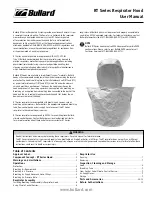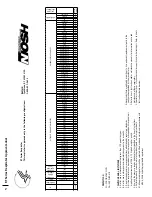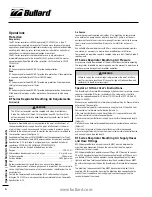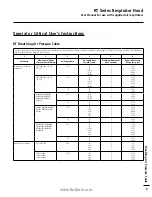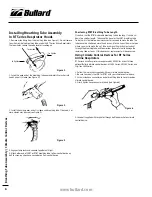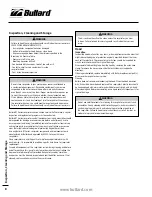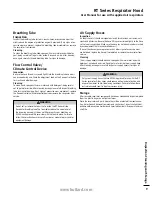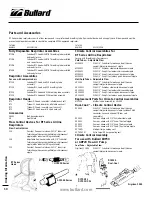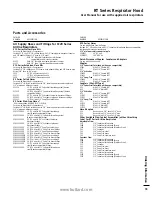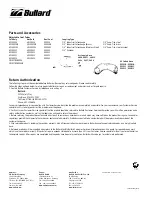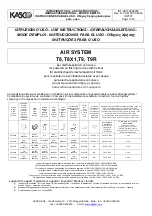
www.bullard.com
9
Inspection Cleaning and Stor
age
RT Series Respirator Hood
User Manual for use with supplied air respirators
Breathing Tube
Inspection
Inspect the breathing tube for tears, cracks, holes, or excessive wear that
might reduce the degree of protection originally provided. If any signs of ex-
cessive wear are present, replace the breathing tube immediately or remove
the respirator from service.
Cleaning
To clean the breathing tube, hand-sponge with warm water and mild deter-
gent, being careful not to get water inside. Rinse and air-dry. After cleaning,
once again carefully inspect breathing tube for signs of damage.
Flow Control Valve/
Climate Control Device
Inspection
Be sure the hose thread is screwed tightly into the breathing tube so no air
can escape during use. Check the adjustment knob on the flow control device
for cracks and other damage.
Cleaning
To clean, hand-sponge with warm water and mild detergent, being careful
not to get water inside. After cleaning, once again carefully inspect breathing
tube for signs of damage. If any signs of excessive wear are present, replace
the flow control valve/climate control device or remove the respirator from
service.
Air Supply Hoses
Inspection
Air supply hose(s) should be inspected closely for abrasions, corrosion, cuts,
cracks and blistering. Be sure the hose fittings are crimped tightly to the hose
so that no air can escape. Make sure the hose has not been kinked or crushed
by any equipment that may have rolled over it.
If any of the above signs are present or any other signs of excessive wear
are detected, replace the hose(s) immediately or remove the respirator from
service.
Cleaning
The air supply hose(s) should be hand-sponged with warm water and mild
detergent, rinsed and air dried. Do not get water inside the air supply hose.
After cleaning, once again carefully inspect air supply hose(s) for signs of
damage.
Storage
After reusable respirator components have been cleaned and inspected, place
them in a plastic bag or an airtight container.
Store the respirator and parts where they will be protected from contamina-
tion, distortion and damage from elements such as dust, direct sunlight, heat,
extreme cold, excessive moisture and harmful chemicals. Five-year maximum
shelf life.
WARNING
Do not cut or remove the foam that is inside the RT Series Airline
Respirator breathing tube. The foam helps reduce the noise level of
the incoming air supply. It does not filter or purify your breathing air.
NIOSH has approved this respirator with the foam in place. Failure to
follow these instructions may result in minor or moderate injury and/or
equipment damage.
WARNING
Only use air supply hoses that are NIOSH approved for use with the RT
Series respirator. Other hoses could reduce airflow and protection, and
expose the wearer to life-threatening conditions. Failure to follow these
instructions could result in death or serious injury.

